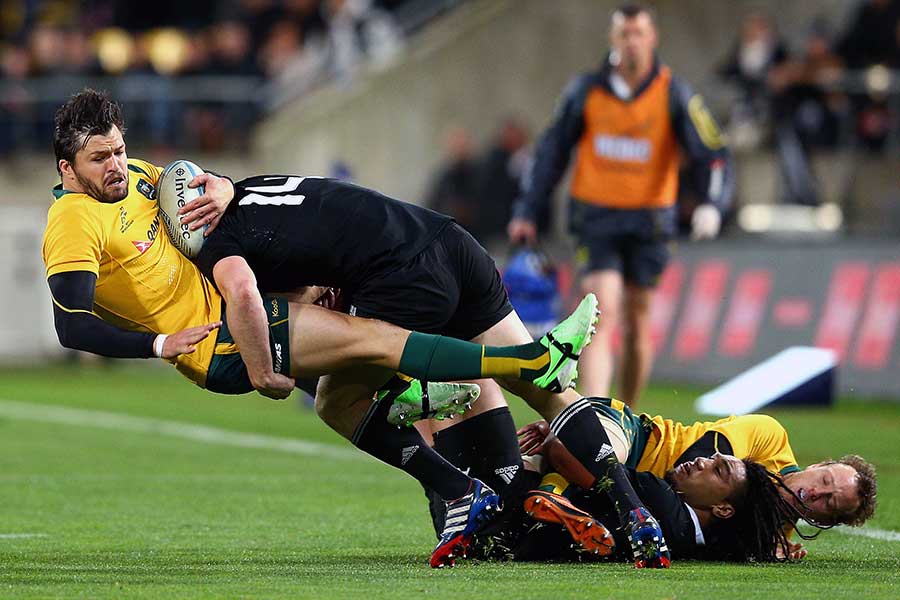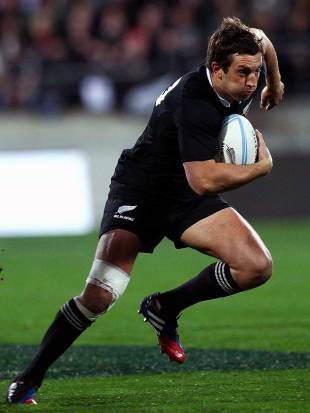|
New Zealand 27 - 16 Australia, Rugby Championship
Five things we learned from Bledisloe II
Andy Withers
August 24, 2013

Ben Smith is damaging equally with or without the ball © Getty Images
Enlarge
Australia travelled to Wellington without, perhaps, the same level of expectation with which they took the field in Sydney seven days earlier, but Wallabies captain James Horwill looked and sounded disappointed beyond belief after his side proved unable either to threaten sufficiently the All Blacks' defence or to resist the cut and thrust of the hosts' attack. What did we learn from the match? What are the key talking points from the Test? ESPNscrum gives some answers.
Brick-wall defence is the foundation of successThe All Blacks boast a backline full of threatening power and intent, and with Ben Smith scoring tries for fun as, perhaps, the best winger in the world at the minute even though he's a better fullback. But for all that firepower, for all that potency, the All Blacks still suffocate and stymie their opponents before slicing and dicing. The Wallabies dominated their rivals through the opening 30 minutes, in both territory and possession, but they scored just six points. "I'm proud of the way the guys stuck in there," Richie McCaw said after the game. "We were under the pump there for a while and to keep them to only six points is handy; then we made their mistakes of theirs pay." Australian fans, and neutral observers, no doubt, will say the All Blacks on occasion pushed past the limit of legality at the breakdown, and that referee Jaco Peyper could even have warned the Kiwis let alone issue cards, but truth is the Wallabies rarely threatened to score a try because the All Blacks' defence was watertight. ESPNscrum correspondent Jeff Wilson wrote earlier in the year how defensive 'glue' was vital for victory, in reference to the Super Rugby competition; the All Blacks have simply made the glue more adhesive.
New Zealand confirmed their trans-Tasman dominance in Wellington (video available only in Australia)
%]
Speed is the key weaponNo matter how good a team's defence, no matter how good a team's defensive alignment, the defence can be breached by speed of deed and thought. Watch the lead-up work in both tries by Ben Smith, with mental speed to spot a gap and pop a pass, handling speed to spin the ball quickly in tight confines, and physical speed to spear clear of opponents, all visible. The All Blacks took advantage of their opportunities. Compare that with the lack of speed from supporting players when Wallabies centre Adam Ashley-Cooper made a break in the first half, the lack of Christian Leali'ifano's physical speed when he speared into space in the same 40 minutes, and the lack of mental speed when the Wallabies piled onto a ruck in the second half without pausing to notice that half-back Will Genia was the first man in. Hence the Wallabies bombed their big opportunities.
Steven Luatua is the real dealThe Blues and All Blacks back-rower has collected plaudits this season, but this was still a breakout performance. He is starting right now only because Liam Messam has a calf injury, and the Chiefs hero, Man of the Match in the Super Rugby final, is likely to reclaim the All Blacks' No.6 jumper when he is fit once again. But he's no walk-up start. Steven Luatua, now with just two Test starts against Australia and a 10-minute cameo off the bench against France has shown he's got the goods. He was solid in defence in Wellington, although some people on the ESPNscrum live commentary want to see him raise his tackle count, and combined that physicality with great handling and searing line speed in broken-field play. His star is firmly in the ascendancy.

Steven Luatua enjoyed a whale of a game in Wellington © Getty Images
Enlarge
The fly-half factory shows no sign of closing

Tom Taylor enjoyed a Test debut to remember
© Getty Images
Enlarge
No Dan Carter, no Aaron Cruden, no Beauden Barrett, no worries for Steve Hansen: other Test teams might be in a state of panic if they get down to their third-choice fly-half; indeed, remember that British & Irish Lions fans panicked about the thought of their No.2 starting. But there are no such fears for New Zealand, for whom Crusaders utility Tom Taylor stepped into the playmaking breach as fourth choice with such aplomb that the aforementioned trio were barely missed. He grew into the game (and the role) with such impressive alacrity, willing to step out of the shadows of his more experienced team-mates, that it seems almost unfeasible that he was reportedly preferred to Colin Slade only because of his superior goal kicking. How much further can New Zealand plumb their depth charts?
Scrums remain a work in progress"Crouch, bind set" was introduced with the aim of making the scrum a contest once again. But the Wallabies seemed to find the scrum feed to be a disadvantage with hooker Stephen Moore unable even to strike on occasion because the All Blacks had the front-rows so low. Now that might just be a result of a superior New Zealand scrum (and the Wallabies' set-piece has long been concerned a weakness), but still you wonder if the new engagement sequence (indeed, the new Laws altogether) need further tweaking. At the moment, Wallabies coach Ewen McKenzie, a grizzled Rugby World Cup-winning prop back in the day when the scrum WAS a content, laments: ""I've honestly got no idea and I used to play in the front-row, I'm lost." © ESPN Sports Media Ltd Andy Withers is the editor of ESPNscrum's Australia and New Zealand pages
|
Live Sports
Communication error please reload the page.
-
Football
-
Cricket
-
Rugby
-
- Days
- Hrs
- Mins
- Secs
F1 - Abu Dhabi GP
Abu Dhabi Grand Prix December 11-131. Max Verstappen ()
2. Valtteri Bottas (Mercedes)
3. Lewis Hamilton (Mercedes)
4. Alexander Albon ()
5. Lando Norris ()
6. Carlos Sainz Jr ()
-
ESPNOtherLive >>
Boxing - Nelson v Wilson; Simmons v Dickinson; Joshua v Gavern (Metro Radio Arena, Newcastle)
Golf - Houston Open
Snooker - China Open
Tennis - Miami Open

